Why is my Haier HRF-663ATA2 making audible sounds?
- MMelissa LewisJul 30, 2025
The fan in your Haier Refrigerator may produce audible sounds when operating. Also, the evaporator lines may produce audible sounds when the temperature is changing.
Why is my Haier HRF-663ATA2 making audible sounds?
The fan in your Haier Refrigerator may produce audible sounds when operating. Also, the evaporator lines may produce audible sounds when the temperature is changing.
What to do if the Haier Refrigerator housing becomes warm during initial operation?
It's normal for the Haier Refrigerator's housing to get warm during initial operation. This is to prevent condensation. If condensation forms on the exterior housing or centre beam during high humidity, wipe it off with a soft cloth.
Automatic ice maker, ice crusher, and refrigerated water dispenser.
Compartment for quick drink retrieval without opening the main door.
Audible warning for open or improperly closed doors.
Automatic cooling adjustment based on internal and ambient temperatures.
Components within the freezer compartment including racks, ice maker, and drawers.
Components within the refrigerator compartment like lights, shelves, and drawers.
Specifies voltage, grounding, and outlet accessibility for safe operation.
Instructions to prevent damage and ensure safe handling of the power cord.
Actions to take in case of a gas or flammable leak.
Safety measure to prevent children from climbing or hanging on the appliance doors.
Warning against storing hazardous materials inside the refrigerator.
Step-by-step guide for removing all packing materials from the appliance.
Procedure for verifying all included accessories are present and accounted for.
Recommendation to clean the appliance's interior before initial operation.
Required waiting period after cleaning before powering on the appliance.
Steps to remove the toe moulding and disconnect the water coupler.
Detailed procedure for removing the freezer door, including hinge and wire disconnection.
Steps to remove the refrigerator door, involving hinge and wire disconnection.
Instructions for reattaching the appliance doors in reverse order.
Importance of a level surface for appliance stability and proper operation.
Procedure for aligning the freezer and refrigerator doors to the same height.
Guidelines for maintaining clearance around the appliance for optimal airflow.
Initial power connection and default operating modes, including memory function.
Explanation of available operating modes: Intelligent and Manual.
Guidance on initial food loading after the appliance has cooled sufficiently.
Detailed identification of all buttons and indicators on the control panel.
Explanation of the Intelligent mode's automatic temperature adjustment feature.
How the display indicates malfunctions and when to contact support.
How to activate and deactivate the Superfrost function for rapid freezing.
Steps for manually adjusting refrigerator and freezer temperatures using specific keys.
Guidance on using the refrigerator compartment for short-term food preservation.
Instructions for adjusting and removing glass shelves for height customization and cleaning.
Explanation of the veggie drawer's function and adjustable humidity control.
Guideline to cool down warm foods and drinks before placing them in the refrigerator.
Importance of sealing foods to prevent drying and odor transfer.
Advice on not overfilling the refrigerator to ensure proper air circulation.
Identification of items that do not require refrigeration and can be stored at room temperature.
List of items unsuitable for refrigeration due to potential accelerated decomposition.
How to operate the home bar compartment and its energy-saving benefit.
Safety instruction to keep children away from the home bar to prevent accidents.
Guidance on using the freezer for long-term food preservation and respecting storage limits.
Instructions for removing and cleaning glass shelves within the freezer compartment.
Advice on portioning food for optimal freezing speed and quality preservation.
Instruction to thaw only the required amount and never refreeze thawed items.
Preparatory steps for the water line, including cutting, routing, and professional installation.
Details for connecting to a water supply line, including pressure and water type recommendations.
Instructions for installing and using a water pump, including safety and grounding requirements.
Safety precautions related to water line temperature, flushing, and installation.
Information on ice cube production rate and factors influencing it.
How to dispense crushed ice using the control panel and lever.
How to dispense ice cubes using the control panel and lever.
How to dispense refrigerated water using the control panel and lever.
Guidance on using the correct glass size and placement for dispensing.
Caution regarding the initial water and ice cubes produced upon first use.
How water supply line issues can impact ice cube size and cause overflow.
Importance of regular cleaning to maintain freshness and prevent odors.
Critical safety step to disconnect power before performing any cleaning.
List of items and substances that should not be used for cleaning.
Guidance on how to manage food during a power outage.
Steps for taking the appliance out of service for extended periods.
Required waiting period before restarting the appliance after it has been turned off.
Identifying normal operational sounds and temperature variations.
Description of audible noises produced by the compressor during startup and shutdown.
Common causes and checks for insufficient cooling performance.
Reasons why the compressor might run frequently or for long periods.
Causes for frost or ice formation on food items within the appliance.
Troubleshooting steps for common ice maker malfunctions.
Troubleshooting for when the dispenser is not supplying ice or water.
Causes and solutions for a jammed ice dispenser mechanism.
Automatic ice maker, ice crusher, and refrigerated water dispenser.
Compartment for quick drink retrieval without opening the main door.
Audible warning for open or improperly closed doors.
Automatic cooling adjustment based on internal and ambient temperatures.
Components within the freezer compartment including racks, ice maker, and drawers.
Components within the refrigerator compartment like lights, shelves, and drawers.
Specifies voltage, grounding, and outlet accessibility for safe operation.
Instructions to prevent damage and ensure safe handling of the power cord.
Actions to take in case of a gas or flammable leak.
Safety measure to prevent children from climbing or hanging on the appliance doors.
Warning against storing hazardous materials inside the refrigerator.
Step-by-step guide for removing all packing materials from the appliance.
Procedure for verifying all included accessories are present and accounted for.
Recommendation to clean the appliance's interior before initial operation.
Required waiting period after cleaning before powering on the appliance.
Steps to remove the toe moulding and disconnect the water coupler.
Detailed procedure for removing the freezer door, including hinge and wire disconnection.
Steps to remove the refrigerator door, involving hinge and wire disconnection.
Instructions for reattaching the appliance doors in reverse order.
Importance of a level surface for appliance stability and proper operation.
Procedure for aligning the freezer and refrigerator doors to the same height.
Guidelines for maintaining clearance around the appliance for optimal airflow.
Initial power connection and default operating modes, including memory function.
Explanation of available operating modes: Intelligent and Manual.
Guidance on initial food loading after the appliance has cooled sufficiently.
Detailed identification of all buttons and indicators on the control panel.
Explanation of the Intelligent mode's automatic temperature adjustment feature.
How the display indicates malfunctions and when to contact support.
How to activate and deactivate the Superfrost function for rapid freezing.
Steps for manually adjusting refrigerator and freezer temperatures using specific keys.
Guidance on using the refrigerator compartment for short-term food preservation.
Instructions for adjusting and removing glass shelves for height customization and cleaning.
Explanation of the veggie drawer's function and adjustable humidity control.
Guideline to cool down warm foods and drinks before placing them in the refrigerator.
Importance of sealing foods to prevent drying and odor transfer.
Advice on not overfilling the refrigerator to ensure proper air circulation.
Identification of items that do not require refrigeration and can be stored at room temperature.
List of items unsuitable for refrigeration due to potential accelerated decomposition.
How to operate the home bar compartment and its energy-saving benefit.
Safety instruction to keep children away from the home bar to prevent accidents.
Guidance on using the freezer for long-term food preservation and respecting storage limits.
Instructions for removing and cleaning glass shelves within the freezer compartment.
Advice on portioning food for optimal freezing speed and quality preservation.
Instruction to thaw only the required amount and never refreeze thawed items.
Preparatory steps for the water line, including cutting, routing, and professional installation.
Details for connecting to a water supply line, including pressure and water type recommendations.
Instructions for installing and using a water pump, including safety and grounding requirements.
Safety precautions related to water line temperature, flushing, and installation.
Information on ice cube production rate and factors influencing it.
How to dispense crushed ice using the control panel and lever.
How to dispense ice cubes using the control panel and lever.
How to dispense refrigerated water using the control panel and lever.
Guidance on using the correct glass size and placement for dispensing.
Caution regarding the initial water and ice cubes produced upon first use.
How water supply line issues can impact ice cube size and cause overflow.
Importance of regular cleaning to maintain freshness and prevent odors.
Critical safety step to disconnect power before performing any cleaning.
List of items and substances that should not be used for cleaning.
Guidance on how to manage food during a power outage.
Steps for taking the appliance out of service for extended periods.
Required waiting period before restarting the appliance after it has been turned off.
Identifying normal operational sounds and temperature variations.
Description of audible noises produced by the compressor during startup and shutdown.
Common causes and checks for insufficient cooling performance.
Reasons why the compressor might run frequently or for long periods.
Causes for frost or ice formation on food items within the appliance.
Troubleshooting steps for common ice maker malfunctions.
Troubleshooting for when the dispenser is not supplying ice or water.
Causes and solutions for a jammed ice dispenser mechanism.
| Brand | Haier |
|---|---|
| Model | HRF-663ATA2 Series |
| Category | Refrigerator |
| Language | English |

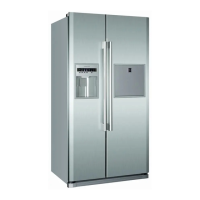
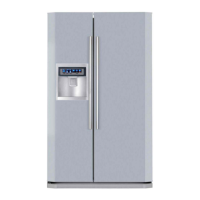
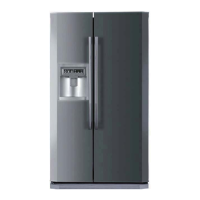


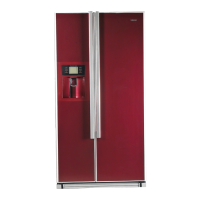

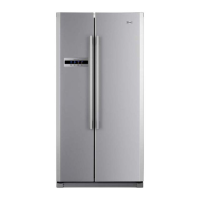

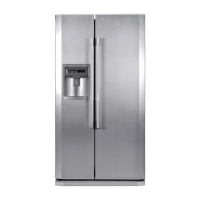
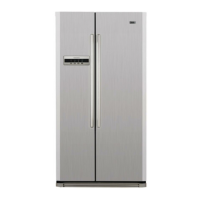
